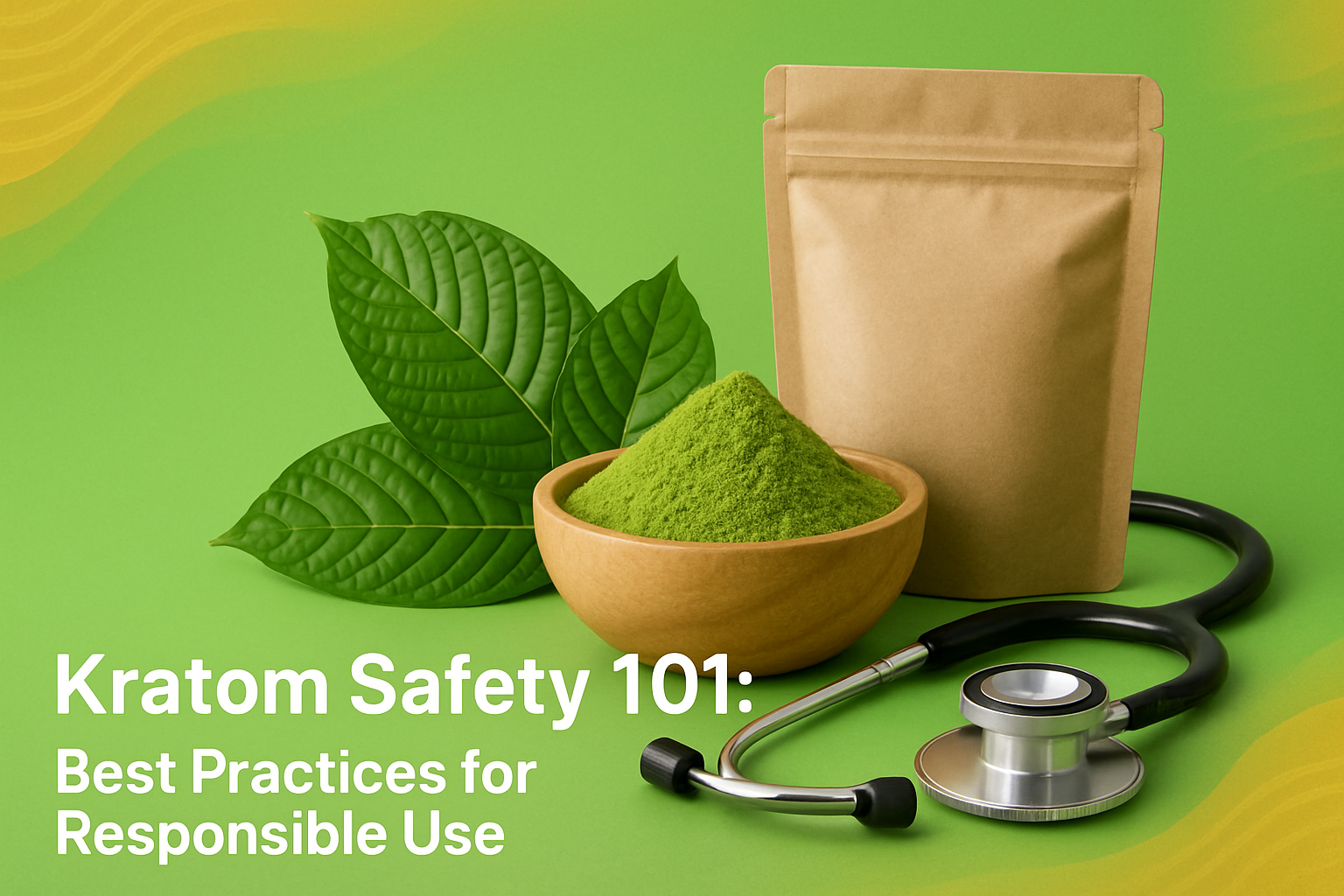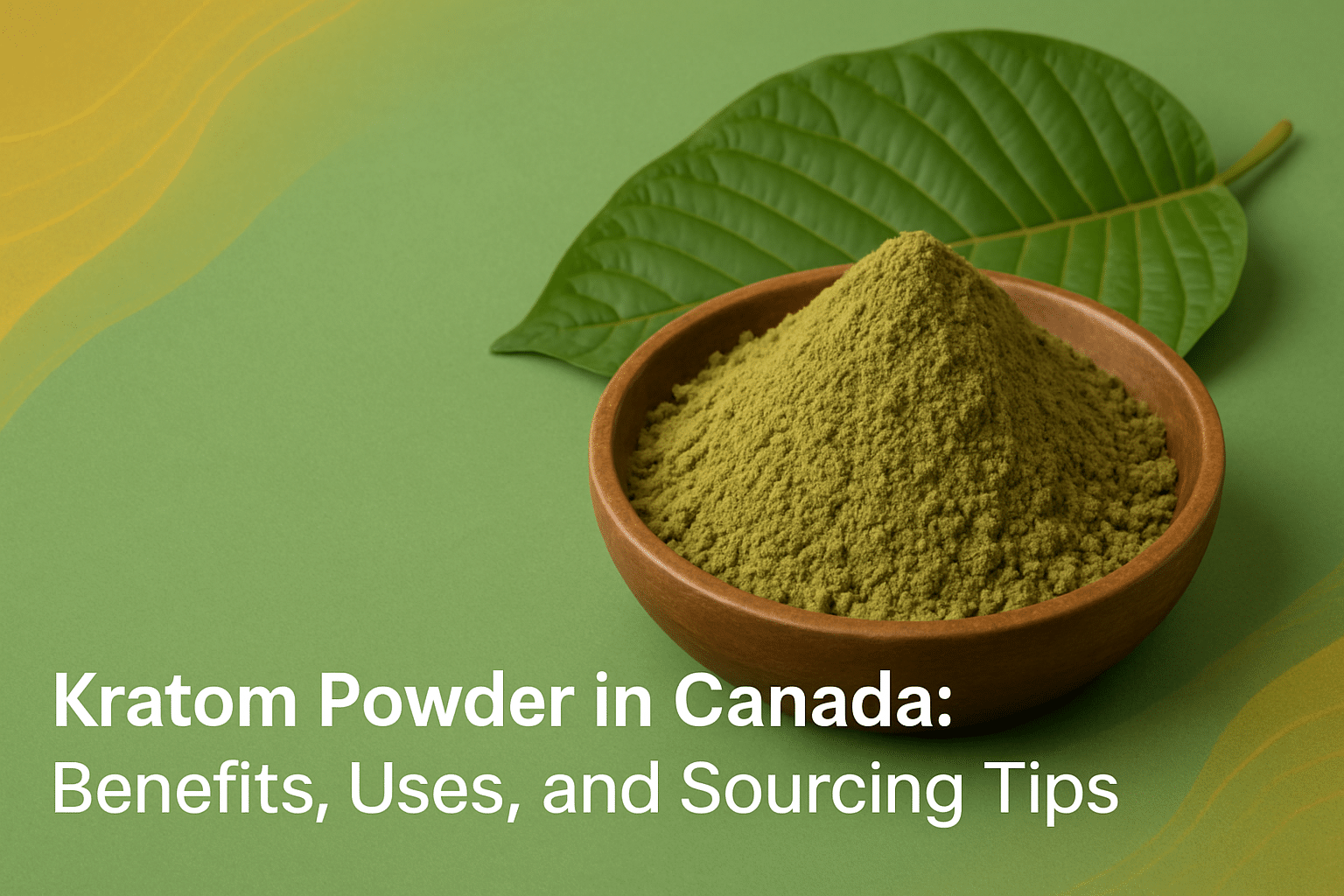
Introduction
Quality kratom experiences begin with one fundamental principle: understanding responsible usage practices. In a landscape where botanical products require careful attention to safety protocols, implementing proper kratom safety measures becomes essential for every user’s wellbeing. Whether you’re exploring kratom for research purposes or seeking natural botanical support, following established safety guidelines ensures both optimal experiences and long-term health protection.
Recent surveys indicate that proper education about kratom safety significantly reduces adverse experiences among users. This comprehensive guide covers everything from dosing protocols to storage practices, helping you navigate the world of kratom with confidence and responsibility. Understanding these best practices isn’t just about safety—it’s about maximizing the potential benefits while minimizing any risks associated with kratom use.
Understanding Safe Kratom Dosing Guidelines
Start Low and Go Slow: Beginner Dosing Protocols
The foundation of safe kratom dosage for beginners lies in patience and gradual introduction. Starting with minimal amounts allows your body to adapt naturally while providing valuable insights into your personal tolerance levels. Most experienced users recommend beginning with doses between 1-2 grams, particularly for those completely new to kratom.
Research supports this conservative approach. In a 2020 U.S. survey, 68% of kratom users reported starting with doses under 3 grams to minimize adverse effects. This data emphasizes the wisdom of beginning with lower amounts and gradually adjusting based on individual response.
Your initial kratom experience should focus on understanding how your body processes the botanical. Wait at least 45-60 minutes before considering any dosage adjustments. This timeframe allows you to properly assess the effects and avoid the common mistake of redosing too quickly.
Strain-Specific Dosing Considerations for Different Effects
Different kratom strains require unique dosing approaches based on their distinct alkaloid profiles and intended effects. Red vein varieties typically produce effects at lower doses compared to green or white strains. Understanding these differences helps optimize your kratom safety practices while achieving desired outcomes.
A 2019 study in Thailand found that red vein strains required 20-30% lower doses for pain relief compared to green strains among 150 participants. This research highlights the importance of adjusting your kratom strain dosing guide based on the specific variety you’re using.
White strains generally require higher doses for mood enhancement, while green strains fall somewhere in between. Creating a personal dosing log helps track which strains work best at specific amounts, leading to more consistent and safer experiences over time.
Recognizing Signs of Optimal vs Excessive Dosing
Identifying the sweet spot between therapeutic effects and excessive dosing is crucial for responsible kratom use. Optimal dosing typically produces subtle, pleasant effects without overwhelming sensations or negative side effects. Common signs of appropriate dosing include improved mood, mild energy enhancement, or gentle relaxation depending on the strain.
Excessive dosing often manifests as nausea, dizziness, or jittery feelings. According to 2021 FDA data, excessive dosing was linked to 44% of reported kratom-related adverse events in the U.S. These statistics underscore the importance of staying within appropriate dosage ranges.
Signs of kratom overdose include severe nausea, rapid heartbeat, extreme drowsiness, or confusion. If you experience any of these symptoms, discontinue use immediately and consider seeking medical attention if symptoms persist or worsen.
Quality Assessment and Lab-Tested Kratom Selection
Identifying High-Quality Kratom: Visual and Aromatic Indicators
High quality kratom indicators begin with visual inspection and aromatic assessment. Premium kratom powder should display vibrant, consistent coloring without any dullness or discoloration. Fresh kratom typically exhibits rich green, red, or white hues depending on the vein type, while old or poorly processed kratom appears faded or brownish.
A 2022 analysis in Indonesia revealed that 75% of high-quality kratom samples exhibited vibrant color and fresh aroma, correlating with higher alkaloid content. This research demonstrates the reliability of sensory evaluation in determining kratom quality.
The aroma of quality kratom should be fresh and earthy, without any musty, sour, or chemical odors. Poor-quality kratom often smells stale or has off-putting scents that indicate improper processing or storage. Trust your senses—they’re valuable tools for initial quality assessment.
Understanding Lab Testing Reports and Purity Certificates
Kratom lab testing importance cannot be overstated when selecting safe, reliable products. Comprehensive lab reports should include tests for heavy metals, pesticides, bacterial contamination, and alkaloid content. These certificates provide transparency and peace of mind regarding product safety.
In a 2023 U.S. report, 82% of lab-tested kratom batches showed no contaminants when certified by third-party labs. This statistic highlights the value of choosing vendors who prioritize testing and quality assurance.
Look for certificates that include specific testing dates, batch numbers, and detailed results for multiple contaminants. Reputable vendors make these reports easily accessible and update them regularly as new batches arrive. Avoid products that lack proper documentation or seem evasive about testing protocols.
Avoiding Contaminated or Adulterated Kratom Products
Contaminated kratom poses serious health risks that extend far beyond typical botanical concerns. Avoid contaminated kratom tips include purchasing only from reputable sources that provide comprehensive testing documentation. Contamination can occur during harvesting, processing, or storage if proper protocols aren’t followed.
A 2018 CDC study identified Salmonella contamination in 20% of untested kratom products in the U.S. This alarming statistic emphasizes why choosing lab-tested products isn’t just recommended—it’s essential for safety.
Warning signs of potentially contaminated kratom include unusually low prices, lack of testing documentation, or vendors who can’t provide clear information about their sourcing and processing methods. When in doubt, choose products from established vendors with strong reputations for quality and transparency.
Responsible Usage Patterns and Tolerance Management
Establishing Healthy Usage Schedules to Prevent Dependence
Creating structured usage patterns forms the cornerstone of responsible kratom consumption. Regular daily use can lead to tolerance and potential dependence, making scheduled breaks an essential component of any long-term usage plan. Most experts recommend limiting usage to specific days rather than daily consumption.
A 2021 survey of 2,798 U.S. users found that limiting use to 3-4 days per week reduced dependence risk by 55%. This research provides clear evidence supporting structured usage schedules as a harm reduction strategy.
Consider implementing a rotating schedule such as using kratom three days, then taking two days off. This pattern allows your body to reset while maintaining the benefits you seek. Track your usage in a journal to ensure you’re sticking to your planned schedule and not gradually increasing frequency.
Rotating Strains and Taking Tolerance Breaks
Rotating kratom strains benefits extend beyond preventing tolerance to include maintaining effectiveness and reducing the risk of dependence. Different strains affect various receptor pathways, so rotation helps prevent your body from becoming accustomed to specific alkaloid profiles.
In a 2020 Malaysian study, strain rotation every 7 days decreased tolerance buildup by 40% in regular users. This research supports the practice of regularly switching between different kratom varieties as part of responsible usage.
Kratom tolerance break schedule should include complete cessation periods of at least one week every month. During these breaks, focus on alternative wellness practices and monitor how your body responds. Many users find that tolerance breaks not only reset their sensitivity but also provide valuable perspective on their relationship with kratom.
Monitoring Your Body’s Response and Adjusting Accordingly
Personal awareness and honest self-assessment form the foundation of responsible kratom use. Pay attention to changes in how kratom affects you over time, including any shifts in dosage requirements or effect duration. Keeping a usage journal helps track patterns and identify potential issues before they become problematic.
Regular self-evaluation should include assessing your motivations for using kratom, monitoring any changes in sleep patterns, appetite, or mood when not using kratom. These indicators can provide early warning signs if your usage is becoming problematic or if you need to adjust your approach.
Consider establishing periodic check-ins with trusted friends or family members who can provide objective observations about any changes in your behavior or wellbeing. External perspectives can be invaluable for maintaining responsible usage patterns and catching potential issues early.
Kratom Interactions and Contraindications to Avoid
Understanding Potential Drug and Supplement Interactions
Kratom drug interactions list includes numerous medications that can create dangerous combinations when used together. The most concerning interactions involve central nervous system depressants, blood thinners, and medications processed by the liver’s CYP3A4 enzyme system.
A 2022 review in Europe noted that kratom interacted with CYP3A4 inhibitors in 30% of cases, increasing adverse effects. This research highlights the importance of understanding how kratom interacts with other substances your body is processing.
Common medications that may interact with kratom include benzodiazepines, opioid pain medications, blood pressure medications, and certain antidepressants. Always research potential interactions before combining kratom with any prescription medications or supplements. When in doubt, maintain separation between kratom use and other substances.
Medical Conditions That May Contraindicate Kratom Use
Kratom medical contraindications include several serious health conditions that may be exacerbated by kratom use. Liver conditions top this list, as kratom is processed by the liver and may stress already compromised hepatic function.
According to 2019 U.S. data, individuals with liver conditions reported complications in 25% of kratom use cases. This statistic underscores the importance of avoiding kratom if you have existing liver problems or are taking medications that affect liver function.
Other contraindications include pregnancy and breastfeeding, severe kidney disease, heart conditions, and psychiatric disorders requiring medication. Mental health conditions may be particularly sensitive to kratom’s effects on mood and perception, potentially interfering with prescribed treatments.
When to Consult Healthcare Professionals About Kratom
Professional medical guidance becomes essential when considering kratom use alongside existing health conditions or medications. Don’t hesitate to discuss kratom with healthcare providers, even if they’re not familiar with the botanical. Your safety depends on transparent communication about all substances you’re considering.
A 2021 Canadian health report advised consultation for 60% of potential users with pre-existing conditions. This recommendation emphasizes that professional guidance should be the norm rather than the exception for many individuals considering kratom use.
Schedule consultations before beginning kratom use if you have any chronic health conditions, take regular medications, or have concerns about potential interactions. Bring research and product information to help your healthcare provider make informed recommendations about your specific situation.
Proper Storage and Handling of Kratom Products
Optimal Storage Conditions to Maintain Potency and Safety
Proper storage practices directly impact both kratom safety and effectiveness. Temperature, humidity, and light exposure all influence alkaloid stability and the risk of contamination. The goal is creating an environment that preserves potency while preventing bacterial or mold growth.
Store kratom properly guide principles include keeping products in airtight containers away from direct sunlight and heat sources. A 2020 study in Southeast Asia showed that airtight storage at room temperature preserved 90% of alkaloids for up to 12 months.
Room temperature storage in dark locations works best for most kratom products. Avoid storing kratom in bathrooms, kitchens, or other areas with high humidity or temperature fluctuations. Basements and closets typically provide ideal storage environments when combined with proper containers.
Preventing Contamination Through Proper Handling Techniques
Clean handling practices prevent introducing contaminants that could compromise kratom safety. Always wash your hands thoroughly before handling kratom products, and use clean, dry utensils for measuring doses. Avoid touching kratom powder directly with your hands whenever possible.
Keep kratom containers tightly sealed between uses to prevent moisture and airborne contaminants from entering. Never use the same measuring tools for different kratom strains without cleaning them first, as cross-contamination can affect both potency and purity.
Store different kratom products separately to maintain strain integrity and prevent accidental mixing. Label containers clearly with strain names and purchase dates to avoid confusion and ensure you’re using products within their optimal timeframes.
Shelf Life Considerations and When to Discard Old Kratom
Kratom shelf life duration varies depending on storage conditions and product quality, but most properly stored kratom remains potent for 12-18 months. However, environmental factors can significantly reduce this timeframe if storage conditions are suboptimal.
In a 2022 U.S. analysis, kratom potency dropped by 50% after 18 months in improper storage. This research demonstrates how storage conditions directly impact product effectiveness and the importance of proper preservation techniques.
Signs that kratom should be discarded include visible mold growth, unusual odors, significant color changes, or any moisture damage to the product or packaging. When in doubt, prioritize safety over cost savings and dispose of questionable products rather than risking contamination or reduced effectiveness.
|
Storage Factor |
Optimal Condition |
Avoid |
|---|---|---|
|
Temperature |
Room temperature (68-72°F) |
Heat sources, refrigeration |
|
Humidity |
Low humidity environments |
Bathrooms, basements |
|
Light |
Dark storage areas |
Direct sunlight, bright lights |
|
Container |
Airtight, non-reactive materials |
Open containers, metal cans |
|
Duration |
Use within 12-18 months |
Indefinite storage |
Frequently Asked Questions
What is considered a safe kratom dosage for beginners?
Beginners should start with 1-2 grams and wait at least 45-60 minutes to assess effects before considering any adjustments. This conservative approach allows your body to adapt gradually while minimizing the risk of adverse reactions. Most safety experts recommend never exceeding 3 grams during initial use phases.
How can I identify signs of kratom overdose?
Signs of kratom overdose include severe nausea, vomiting, extreme drowsiness, confusion, rapid heartbeat, and dizziness. These symptoms indicate excessive dosing and require immediate discontinuation of kratom use. If symptoms persist or worsen, seek medical attention promptly.
Why is kratom lab testing importance so critical for safety?
Lab testing ensures kratom products are free from harmful contaminants including heavy metals, pesticides, bacteria, and adulterants. Testing also verifies alkaloid content and potency, helping users make informed decisions about dosing. Products without testing documentation pose unnecessary health risks.
What medications should I avoid while using kratom?
Avoid combining kratom with central nervous system depressants, blood thinners, liver medications, and substances processed by CYP3A4 enzymes. This includes benzodiazepines, opioids, certain antidepressants, and blood pressure medications. Always consult healthcare providers about potential interactions.
How long does properly stored kratom remain effective?
Properly stored kratom maintains optimal potency for 12-18 months when kept in airtight containers at room temperature away from light and moisture. Storage conditions significantly impact longevity, with improper storage reducing effectiveness by up to 50% after 18 months.
Conclusion
Implementing comprehensive kratom safety practices ensures both immediate wellbeing and long-term positive experiences with this botanical. From understanding proper dosing guidelines to maintaining quality storage conditions, each safety measure contributes to responsible usage that prioritizes health and effectiveness.
Remember that kratom safety isn’t just about following guidelines—it’s about developing a mindful relationship with botanical products that respects both their potential benefits and inherent responsibilities. Regular self-assessment, quality product selection, and adherence to proven safety protocols form the foundation of responsible kratom use.
Ready to experience lab-tested, premium kratom with complete safety documentation? Explore 365 Kratom Canada’s collection of expertly crafted blends, including their popular Sunrise and Clarity formulations, all backed by comprehensive purity testing and safety certifications.



